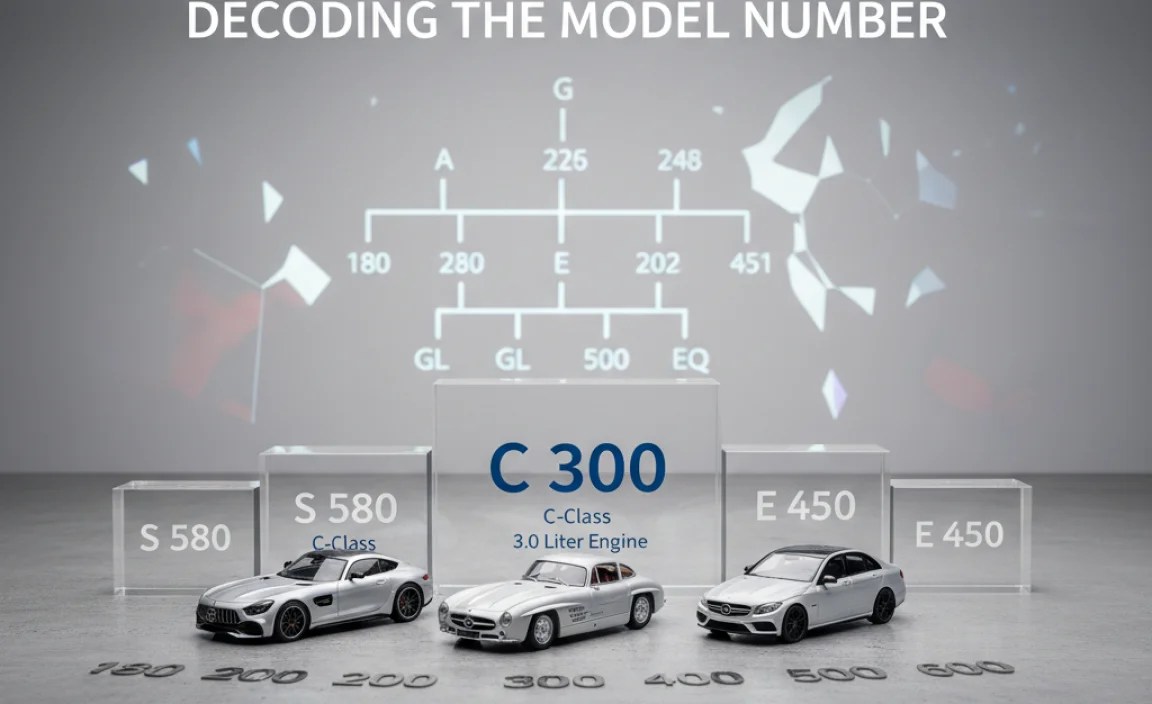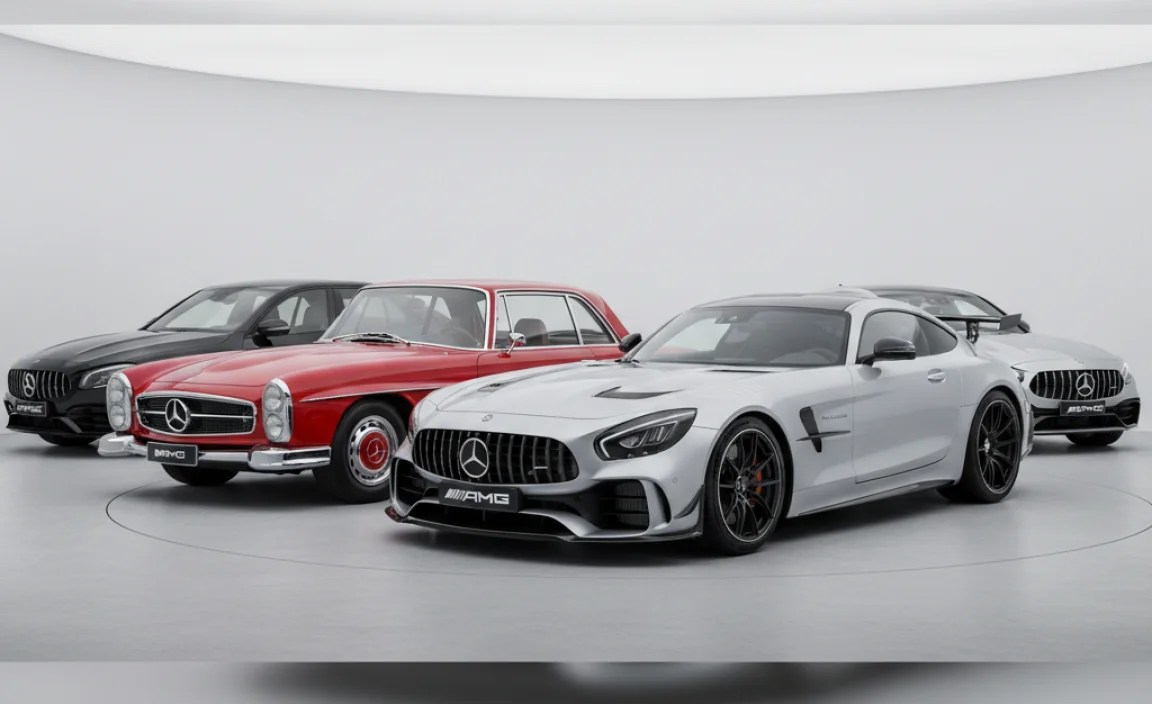Understanding Mercedes-Benz Model Lineage
Quick Summary: Unraveling the Mercedes-Benz model lineage can seem daunting, but it’s simpler than you think! Mercedes uses a system to categorize its vehicles, which includes letters (like C, E, S) indicating the class or size, and numbers representing the engine’s relative power. Understanding this system helps you quickly identify different models and their position in the Mercedes-Benz family. This guide breaks down the Mercedes model naming conventions, making it easy to decode the lineup and find the perfect Mercedes for you.
Ever wondered what all those letters and numbers on the back of a Mercedes-Benz actually mean? It can feel like a secret code! Knowing the Mercedes model lineage helps you understand the differences between a C-Class and an S-Class, or an AMG versus a standard model. It’s actually a straightforward system once you learn the basics. This guide will help you easily decode Mercedes model names, so you can confidently navigate the lineup and understand the heritage behind these luxury vehicles.
Ready to become a Mercedes-Benz expert? Let’s dive in and decode the model lineage, step by step!
Understanding Mercedes-Benz Model Lineage

Mercedes-Benz uses a specific naming convention to categorize its vehicles. This system includes letters that denote the class (size and type of vehicle) and numbers that indicate the engine’s relative power. Let’s break it down:
Core Model Classes
The core of the Mercedes-Benz lineup is defined by several key classes:
- A-Class: Compact luxury vehicles, including hatchbacks and sedans.
- B-Class: Compact multi-purpose vehicle (MPV), offering practicality and efficiency (primarily available in Europe and other select markets).
- C-Class: Compact executive cars, including sedans, coupes, and convertibles.
- E-Class: Mid-size executive cars, known for their comfort and technology, available in sedan, coupe, convertible, and wagon body styles.
- S-Class: Full-size luxury sedans, representing the pinnacle of Mercedes-Benz luxury and innovation.
- G-Class: Iconic off-road SUVs, known for their ruggedness and luxurious features.
- V-Class: Large MPV, offering spaciousness and versatility for passengers and cargo (primarily available in Europe and other select markets).
SUV Model Classes
Mercedes-Benz also offers a comprehensive range of SUVs, each designated with a “GL” prefix followed by a letter indicating its relationship to the core model classes:
- GLA: Compact crossover SUV, based on the A-Class.
- GLB: Compact SUV, positioned between the GLA and GLC, offering available third-row seating.
- GLC: Compact SUV, related to the C-Class.
- GLE: Mid-size SUV, related to the E-Class.
- GLS: Full-size SUV, related to the S-Class, offering maximum luxury and space.
- EQS SUV: All-electric full-size SUV, based on the EQS sedan.
- EQE SUV: All-electric mid-size SUV, based on the EQE sedan.
Coupe and Roadster Model Classes
Mercedes-Benz offers stylish coupes and roadsters, often derived from their sedan counterparts:
- CLA: Four-door coupe, based on the A-Class.
- CLS: Four-door coupe, positioned between the E-Class and S-Class.
- E-Class Coupe/Convertible: Two-door versions of the E-Class.
- S-Class Coupe/Convertible: Two-door versions of the S-Class (discontinued after 2020 model year).
- SL: Roadster, a sporty and luxurious convertible.
- SLC (formerly SLK): Compact roadster (discontinued).
Electric Vehicle Model Classes (EQ)
Mercedes-Benz is expanding its electric vehicle lineup under the “EQ” sub-brand:
- EQA: All-electric compact SUV.
- EQB: All-electric compact SUV with available third-row seating.
- EQC: All-electric SUV (discontinued in some markets).
- EQE: All-electric mid-size sedan, related to the E-Class.
- EQS: All-electric full-size sedan, representing the electric equivalent of the S-Class.
- EQV: All-electric van.
Decoding the Model Number

After the class designation (the letter or letters), you’ll find a number. This number generally indicates the engine’s relative power output. Higher numbers usually mean more powerful engines, but it’s not a direct correlation to engine displacement (e.g., liters). Here’s how to interpret the numbers:
- Lower Numbers (e.g., 180, 200, 220): Typically indicate smaller, more fuel-efficient engines, often four-cylinder.
- Mid-Range Numbers (e.g., 300, 350, 400): Usually represent more powerful four-cylinder engines, V6 engines, or hybridized systems.
- Higher Numbers (e.g., 500, 550, 580): Indicate powerful V8 engines or high-performance hybrid systems.
- Electric Models (e.g., EQE 350, EQS 580): Numbers represent the electric powertrain’s performance level and battery capacity.
Example: A C300 will generally have a more powerful engine than a C200.
Additional Designations

Mercedes-Benz also uses additional designations to provide more information about the vehicle’s features and powertrain:
- 4MATIC: Indicates all-wheel drive.
- d: Denotes a diesel engine (e.g., C220d).
- e: Indicates a plug-in hybrid (e.g., C300e).
- h: Indicates a hybrid (no longer commonly used).
- AMG: High-performance models developed by Mercedes-AMG.
AMG: The Performance Division

AMG (formerly Aufrecht Melcher Großaspach, now Mercedes-AMG) is the high-performance division of Mercedes-Benz. AMG models feature significantly enhanced engines, performance-tuned suspensions, upgraded brakes, and unique styling elements. AMG models are designated with either a two-digit number (e.g., AMG C43, AMG E53) or a three-digit number (e.g., AMG C63, AMG GT 63). The higher the number, the more powerful and performance-oriented the vehicle.
Examples:
- AMG C43: A performance-enhanced version of the C-Class with a potent engine and sporty features.
- AMG C63: The highest-performance version of the C-Class, featuring a handcrafted engine and track-focused upgrades.
Generational Changes and Facelifts

It’s important to note that each Mercedes-Benz model goes through generational changes (new model series) and facelifts (mid-cycle updates). These changes can bring about alterations in styling, technology, and engine options. To identify the specific generation of a Mercedes-Benz model, you can refer to its model year and internal model code (e.g., W205 for the previous generation C-Class sedan, W206 for the current generation).
Mercedes-Benz Model Lineage: A Detailed Overview
To further illustrate the Mercedes-Benz model lineage, let’s examine a detailed table showcasing various models, their body styles, and their corresponding class designations.
| Model | Body Style | Class | Description |
|---|---|---|---|
| A-Class | Hatchback, Sedan | Compact | Entry-level luxury vehicle, offering a blend of style and technology. |
| B-Class | MPV | Compact | Practical and efficient multi-purpose vehicle (primarily available in Europe). |
| C-Class | Sedan, Coupe, Convertible | Compact Executive | Popular luxury car, known for its comfort and performance. |
| E-Class | Sedan, Coupe, Convertible, Wagon | Mid-Size Executive | Sophisticated and technologically advanced, offering a range of body styles. |
| S-Class | Sedan | Full-Size Luxury | Flagship model, representing the pinnacle of Mercedes-Benz luxury and innovation. |
| G-Class | SUV | Off-Road Luxury | Iconic and rugged off-road SUV with luxurious features. |
| GLA | SUV | Compact Crossover | Compact SUV, based on the A-Class, offering a sporty driving experience. |
| GLB | SUV | Compact | Compact SUV with available third-row seating. |
| GLC | SUV, Coupe | Compact | Popular SUV, related to the C-Class, offering a balance of comfort and utility. |
| GLE | SUV, Coupe | Mid-Size | Versatile SUV, related to the E-Class, with a spacious interior. |
| GLS | SUV | Full-Size | Full-size SUV, related to the S-Class, offering maximum luxury and space. |
| CLA | Four-Door Coupe | Compact | Stylish four-door coupe, based on the A-Class. |
| CLS | Four-Door Coupe | Mid-Size | Elegant four-door coupe, positioned between the E-Class and S-Class. |
| SL | Roadster | Roadster | Sporty and luxurious convertible, offering open-top driving enjoyment. |
| EQA | SUV | Compact Electric | All-electric compact SUV. |
| EQB | SUV | Compact Electric | All-electric compact SUV with available third-row seating. |
| EQE | Sedan, SUV | Mid-Size Electric | All-electric mid-size sedan, related to the E-Class. |
| EQS | Sedan, SUV | Full-Size Electric | All-electric full-size sedan, representing the electric equivalent of the S-Class. |
Tips for Staying Updated
The Mercedes-Benz model lineup is constantly evolving with new models, updates, and technologies. Here are some tips for staying informed:
- Official Mercedes-Benz Website: Visit the official Mercedes-Benz website (www.mbusa.com) for the latest model information and configurations.
- Automotive News Websites: Stay updated with reputable automotive news websites like Car and Driver, Motor Trend, and Road & Track.
- Mercedes-Benz Forums: Engage with online communities and forums dedicated to Mercedes-Benz vehicles for discussions and insights.
FAQ: Decoding Mercedes-Benz Models
What does the “C” in C-Class stand for?
The “C” in C-Class stands for “Compact,” indicating that it’s a compact executive car within the Mercedes-Benz lineup.
What does “4MATIC” mean?
“4MATIC” is Mercedes-Benz’s designation for its all-wheel-drive system, providing enhanced traction and stability in various driving conditions.
How do I know if a Mercedes-Benz is an AMG model?
AMG models are typically designated with “AMG” badging on the rear of the vehicle and often feature unique styling elements, such as aggressive body kits and performance wheels. The model number will also typically be a two- or three-digit number (e.g., AMG C43, AMG C63).
What does the “e” in C300e mean?
The “e” in C300e indicates that it’s a plug-in hybrid vehicle, combining a gasoline engine with an electric motor for increased efficiency and performance.
Are the numbers in the model name directly related to engine displacement?
Not always. While higher numbers generally indicate more powerful engines, they don’t directly correlate to engine displacement in liters. For example, a C300 might have a turbocharged four-cylinder engine, while a previous generation C300 could have had a V6.
What is the difference between a GLA and a GLC?
Both are SUVs, but the GLA is a compact crossover based on the A-Class, while the GLC is a compact SUV related to the C-Class. The GLC is generally larger and offers more interior space.
What is the EQ sub-brand?
EQ is Mercedes-Benz’s sub-brand for its all-electric vehicles. Models like the EQE and EQS represent the electric equivalents of the E-Class and S-Class, respectively.
Conclusion
Understanding the Mercedes-Benz model lineage doesn’t have to be confusing. By grasping the basic principles of class designations, model numbers, and additional identifiers, you can easily navigate the extensive Mercedes-Benz lineup. Whether you’re a seasoned enthusiast or a first-time buyer, this knowledge empowers you to make informed decisions and appreciate the rich heritage of Mercedes-Benz vehicles. Now you can confidently decode those model names and impress your friends with your Mercedes-Benz knowledge!





